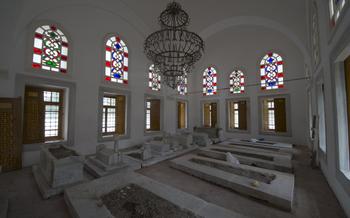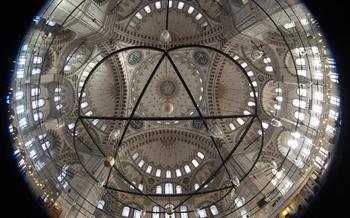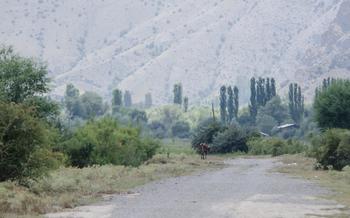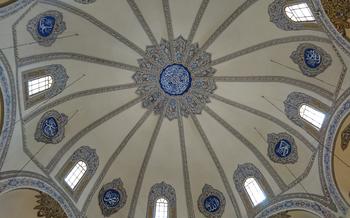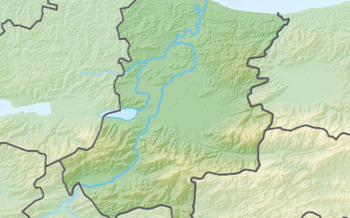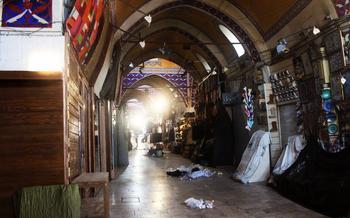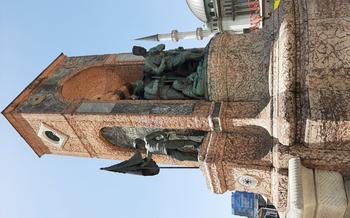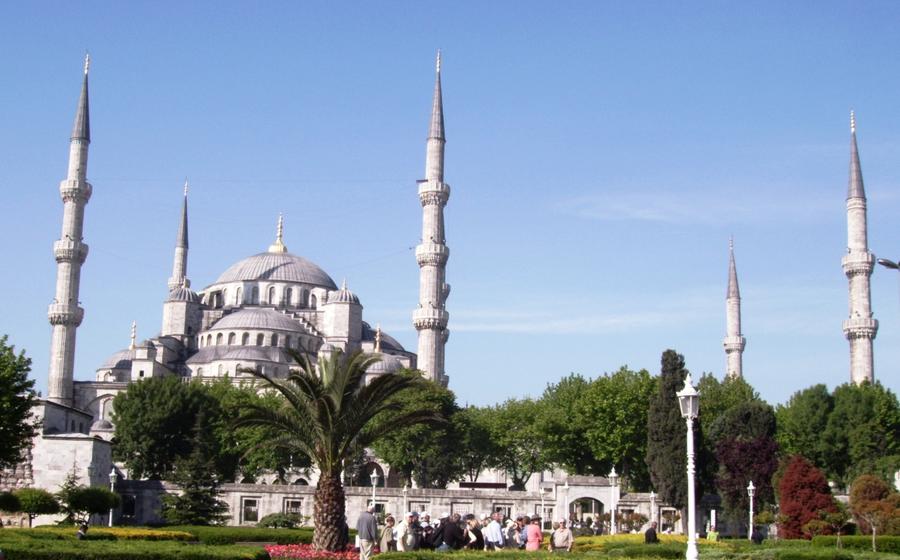
Blue Mosque (Sultanahmet Camii)
- A Monumental Masterpiece: The Blue Mosque's Historical Significance
- Captivating Interiors: Unveiling the Blue Mosque's Artistic Treasures
- A Spiritual Haven: Experiencing the Blue Mosque as a Place of Worship
- Harmony of Cultures: The Blue Mosque's Location in Istanbul's Historic Center
- Exploring the Neighborhood: Hidden Gems Around the Blue Mosque
- Planning Your Visit: Practical Tips for a Smooth Experience
- Capturing the Essence: Tips for Stunning Blue Mosque Photographs
- A Journey Through Time: The Blue Mosque's Role in History
- Behind the Scenes: The Blue Mosque's Architectural Marvels
- The Blue Mosque in Literature and Art: A Source of Inspiration
- A Place of Serenity: Finding Tranquility in the Blue Mosque's Prayer Hall
- The Blue Mosque's Enduring Legacy: A Symbol of Faith and Cultural Heritage
- The Blue Mosque's Role in Interfaith Dialogue and Understanding
- The Blue Mosque's Impact on Tourism in Istanbul
- Insider Tip: Unveiling the Blue Mosque's Secret Garden
A Monumental Masterpiece: The Blue Mosque's Historical Significance
The Blue Mosque stands as a testament to the grandeur and artistry of the Ottoman Empire. Commissioned by Sultan Ahmed I in the early 17th century, its construction marked a pivotal moment in Islamic architecture and symbolized the empire's continued dominance. The mosque's design incorporated elements from both Byzantine and Islamic traditions, reflecting the cultural and religious diversity that characterized the Ottoman Empire.
The Blue Mosque, also known as Sultanahmet Camii, is one of Istanbul's most iconic landmarks and a masterpiece of Islamic architecture. Completed in 1616, it is renowned for its exquisite blue tiles, intricate dome, and six towering minarets. The mosque's history is intertwined with the rise and fall of the Ottoman Empire, and it remains an active place of worship for Muslims around the world.
Architecturally, the Blue Mosque is a marvel of engineering and design. Its vast dome, intricate arches, and graceful minarets showcase the skill and ingenuity of Ottoman builders. The mosque's interior is adorned with stunning Iznik tiles, stained glass windows, and elaborate calligraphy, creating a breathtaking visual spectacle.
Beyond its architectural significance, the Blue Mosque holds immense cultural and religious importance. It serves as a symbol of Islamic faith and devotion, attracting millions of visitors each year. The mosque's daily prayer rituals and religious ceremonies offer a glimpse into the rich spiritual traditions of Islam.
Captivating Interiors: Unveiling the Blue Mosque's Artistic Treasures
Step inside the Blue Mosque, and prepare to be mesmerized by its breathtaking interior. The walls are adorned with exquisite Iznik tiles, each one hand-painted with intricate floral and geometric designs. These tiles create a symphony of colors, with shades of blue, green, and red dominating the palette. The vibrant hues seem to dance in the light, creating an ethereal atmosphere.
The dazzling stained glass windows of the Blue Mosque are another sight to behold. These windows, with their intricate patterns and vibrant colors, cast a kaleidoscope of light onto the interior, transforming the space into a magical realm. The light dances and shimmers, creating an enchanting play of shadows and colors.
The Blue Mosque's interior is further embellished with ornate calligraphy and decorations. Verses from the Quran are inscribed in elegant Arabic script, adorning the walls and arches. These inscriptions, with their intricate flourishes and graceful lines, add a layer of spiritual significance to the mosque's interior. The overall effect is one of awe-inspiring beauty, a testament to the skill and artistry of the mosque's builders.
A Spiritual Haven: Experiencing the Blue Mosque as a Place of Worship
As a place of worship, the Blue Mosque exudes an atmosphere of profound spirituality. Daily prayer rituals, meticulously observed by devout Muslims, create a captivating spectacle. The melodious call to prayer, echoing through the mosque's minarets, reverberates through the neighborhood, summoning the faithful to congregate. The interior transforms into a sea of worshippers, prostrating in unison, their movements harmonized in a symphony of devotion.
Respectful behavior is paramount when visiting the mosque during prayer times. Visitors are expected to maintain silence and refrain from distracting activities. Observing the rituals from a discreet distance allows one to witness the depth of faith and reverence that permeates this sacred space. The mosque serves as a vital hub for the Muslim community, fostering a sense of belonging and spiritual connection.
Before entering the prayer hall, visitors are encouraged to perform ablution at the designated fountains, a symbolic purification ritual. This act signifies a state of cleanliness and readiness for prayer. By following these customs and demonstrating respect for the mosque's religious significance, visitors contribute to the preservation of its sacred atmosphere.
Harmony of Cultures: The Blue Mosque's Location in Istanbul's Historic Center
In the heart of Istanbul's historic center, where the past and present intertwine, the Blue Mosque stands tall, a testament to the city's rich cultural heritage. Its strategic location, adjacent to the iconic Hagia Sophia and the opulent Topkapi Palace, speaks volumes about the mosque's significance in the development of Istanbul's urban fabric.
During the Ottoman Empire, the Blue Mosque served as a symbol of the empire's power and grandeur. Its proximity to the imperial palace and the Hagia Sophia, which was converted into a mosque in 1453, underscored the Ottoman dynasty's commitment to Islam and its desire to make Istanbul the new capital of their vast empire.
Architecturally, the Blue Mosque represents a harmonious blend of Islamic and Byzantine influences, reflecting Istanbul's unique position as a bridge between the East and the West. While its domes and minarets are reminiscent of traditional Islamic architecture, the use of intricate tilework and mosaics, inspired by Byzantine art, showcases the city's rich cultural diversity.
Exploring the neighborhood surrounding the Blue Mosque is like embarking on a journey through time. Sultanahmet Square, the heart of Istanbul's historic center, was once the ancient Hippodrome, where chariot races and other spectacles took place during the Byzantine era. Today, it serves as a vibrant public space, where visitors can admire the mosque's imposing facade and soak in the city's bustling atmosphere.
A short walk from the Blue Mosque leads to the Grand Bazaar, one of the oldest and largest covered markets in the world. With its labyrinthine alleys and countless shops selling everything from carpets and jewelry to spices and souvenirs, the Grand Bazaar offers a glimpse into Istanbul's vibrant trading history.
In essence, the Blue Mosque stands as a testament to Istanbul's rich cultural heritage, where Islamic and Byzantine influences intertwine to create a unique and captivating cityscape. Its proximity to other iconic landmarks, such as Hagia Sophia and Topkapi Palace, highlights the mosque's importance in the city's history and its role as a symbol of Istanbul's enduring cultural legacy.
Exploring the Neighborhood: Hidden Gems Around the Blue Mosque
Venturing beyond the Blue Mosque's awe-inspiring interiors, the surrounding neighborhood of Sultanahmet unveils a tapestry of hidden treasures. Just steps away, the iconic Sultanahmet Square, once the heart of the ancient Hippodrome, beckons with its rich history and remnants of Byzantine grandeur. Gaze upon the imposing obelisk brought from Egypt, the serpentine column, and the German Fountain, relics of a bygone era.
Immerse yourself in the vibrant tapestry of the Grand Bazaar, a labyrinth of over 4,000 shops where haggling is an art form. Discover intricate carpets, shimmering jewelry, aromatic spices, and an array of souvenirs that reflect Turkey's diverse cultural heritage.
For a more tranquil shopping experience, wander through the serene Arasta Bazaar, located directly behind the Blue Mosque. This charming bazaar, once reserved for the elite, offers a curated selection of high-quality carpets, antiques, and handicrafts, ensuring a unique and memorable shopping experience.
Indulge your taste buds with the culinary delights of the neighborhood. Savor the flavors of traditional Turkish cuisine at one of the many restaurants lining the cobblestone streets, where you can feast on delectable kebabs, succulent mezes, and the ever-popular Turkish delight.
Planning Your Visit: Practical Tips for a Smooth Experience
Best Time to Visit for Fewer Crowds To avoid the throngs of tourists, plan your visit outside of the peak season (June to August) and the busiest times of day (late morning and early afternoon). Consider visiting during the shoulder months (April-May and September-October) or even during the winter months (November-March) for a more tranquil experience.
Dress Code and Appropriate Attire As a place of worship, the Blue Mosque has a dress code that requires visitors to dress modestly. For women, this means covering their heads with a scarf or headscarf and wearing loose-fitting clothing that covers their shoulders and knees. Men are expected to wear long pants and a shirt with sleeves.
Guided Tours and Self-Guided Exploration Guided tours are an excellent way to learn more about the history, architecture, and cultural significance of the Blue Mosque. However, if you prefer to explore at your own pace, opt for a self-guided tour. Audio guides and information brochures are available to provide insights into the mosque's various features.
Capturing the Essence: Tips for Stunning Blue Mosque Photographs
The Blue Mosque stands as a magnificent subject for photography, offering endless opportunities to capture its architectural grandeur and intricate details. Here are some tips to help you take stunning photographs of this iconic landmark:
-
Embrace the Vantage Points: Seek out strategic vantage points to capture panoramic views of the mosque. The surrounding Sultanahmet Square and the park area opposite the mosque offer excellent perspectives.
-
Harness the Light: Choose the right time of day to take your shots. The morning light, with its warm golden hues, beautifully illuminates the mosque's exterior. Conversely, the evening light, as the sun sets, creates a magical ambiance, casting long shadows that enhance the mosque's architectural details.
-
Compose Your Shot: Pay attention to composition to create visually appealing images. Include elements like the mosque's minarets, domes, and arches to showcase its unique features. Experiment with different angles and perspectives to find the most compelling composition.
A Journey Through Time: The Blue Mosque's Role in History
The Blue Mosque stands as a testament to the grandeur and ambition of the Ottoman Empire. Commissioned by Sultan Ahmed I in the early 17th century, its construction marked a pivotal moment in Ottoman history. The mosque's sheer size and opulent decoration reflected the empire's growing power and wealth. At the time, it was the largest mosque in the world, symbolizing the sultan's desire to surpass the achievements of his predecessors and leave a lasting legacy.
The Blue Mosque's construction also coincided with a period of intense rivalry between the Ottoman Empire and its European counterparts. By erecting such an awe-inspiring edifice, Sultan Ahmed I aimed to demonstrate the empire's architectural prowess and assert its dominance in the region. The mosque's strategic location, adjacent to Hagia Sophia and Topkapi Palace, further emphasized its significance as a symbol of Ottoman authority.
Throughout the centuries, the Blue Mosque has witnessed countless historical events, from religious ceremonies to political gatherings. It has served as a place of worship, a center of learning, and a venue for important state functions. Its enduring presence has made it an integral part of Istanbul's rich history and a reminder of the city's status as a crossroads of cultures and civilizations.
Behind the Scenes: The Blue Mosque's Architectural Marvels
The Blue Mosque stands as a testament to the ingenuity and architectural prowess of the Ottoman Empire. Its construction showcased several innovations that pushed the boundaries of engineering and design.
The mosque's six minarets, a unique feature among Ottoman mosques, not only serve as visual landmarks but also hold symbolic significance. The four minarets at the corners of the mosque represent the four caliphs of Islam, while the two minarets flanking the main entrance symbolize the two sons of Sultan Ahmed I.
The intricate dome design of the Blue Mosque is another masterpiece of architectural engineering. The central dome, measuring an impressive 25 meters in diameter, rests on four massive pillars and is supported by a series of semi-domes and arches. This complex structural system allows for an expansive interior space that can accommodate thousands of worshippers.
The calligraphy adorning the Blue Mosque's interior is a testament to the skill and artistry of Ottoman calligraphers. Verses from the Quran and the names of Allah, the Prophet Muhammad, and the four caliphs are inscribed in elegant Arabic script on the walls, domes, and arches. These inscriptions not only enhance the mosque's aesthetic appeal but also serve as reminders of its religious significance.
The Blue Mosque's architectural marvels are a testament to the ingenuity and creativity of the Ottoman architects and builders. Every element of the mosque, from its soaring domes to its intricate tilework, showcases the empire's commitment to architectural excellence and its enduring legacy as a center of Islamic culture and art.
The Blue Mosque in Literature and Art: A Source of Inspiration
The Blue Mosque's captivating beauty and historical significance have left an indelible mark on the world of literature and art. Renowned authors and artists have been inspired by its grandeur, incorporating it into their works as a symbol of faith, cultural heritage, and architectural marvel.
In literature, the Blue Mosque has been featured prominently in novels, travelogues, and poems. Celebrated Turkish author Orhan Pamuk, in his novel "My Name is Red," paints a vivid picture of the mosque's construction and its impact on the city's cultural landscape. Similarly, British novelist Elif Shafak's "The Architect's Apprentice" delves into the historical context of the mosque's creation, exploring the intricate relationship between art, power, and religion.
In the realm of art, the Blue Mosque has served as a muse for countless painters, photographers, and illustrators. Its distinctive silhouette and intricate details have been captured in a variety of mediums, from oil paintings to watercolors, showcasing the mosque's beauty from various perspectives. Renowned Turkish artist Mimar Sinan, who is credited with designing the mosque, left behind a legacy of architectural drawings and sketches that provide valuable insights into the mosque's design and construction process.
The Blue Mosque's influence extends beyond traditional forms of art, reaching into contemporary culture as well. Filmmakers have used the mosque as a backdrop for historical dramas and documentaries, highlighting its role in shaping Istanbul's identity. Fashion designers have drawn inspiration from the mosque's motifs and patterns, incorporating them into their designs as a symbol of cultural fusion and appreciation.
Through literature and art, the Blue Mosque continues to captivate hearts and minds, transcending its role as a place of worship and becoming a symbol of Istanbul's rich cultural heritage and a source of inspiration for generations to come.
A Place of Serenity: Finding Tranquility in the Blue Mosque's Prayer Hall
Beyond its stunning aesthetics, the Blue Mosque serves as a profound spiritual sanctuary for Muslims worldwide. The mosque's vast prayer hall, capable of accommodating thousands of worshippers, exudes an atmosphere of tranquility and devotion. The spacious interior is adorned with intricate carpets, elegant chandeliers, and mesmerizing calligraphy, creating a serene ambiance conducive to contemplation and prayer.
At the heart of the prayer hall lies the Qibla wall, which indicates the direction of Mecca and serves as a focal point for worshippers. The mihrab, a niche in the Qibla wall, holds immense religious significance as the spot where the imam leads the prayers. The intricate designs and verses adorning the mihrab add to the spiritual aura of the prayer hall, inspiring a sense of reverence among the faithful.
Observing the rituals of ablution and prayer within the Blue Mosque is a humbling experience, offering a glimpse into the devout practices of Islam. Visitors are welcome to witness these rituals from a designated area, ensuring respect for worshippers' privacy while providing a unique opportunity to understand Islamic traditions firsthand.
The Blue Mosque's Enduring Legacy: A Symbol of Faith and Cultural Heritage
The Blue Mosque stands as a testament to the enduring legacy of Islamic architecture and cultural heritage. Its construction marked a significant milestone in Ottoman history, showcasing the empire's architectural prowess and religious devotion. The mosque's intricate design and awe-inspiring grandeur have made it a symbol of faith and a source of pride for Muslims worldwide.
Beyond its religious significance, the Blue Mosque has played a pivotal role in shaping Istanbul's cultural landscape. Its unique fusion of Islamic and Byzantine architectural elements has created a harmonious dialogue between different cultures and eras. The mosque's presence in the heart of Istanbul, alongside other iconic landmarks such as Hagia Sophia and Topkapi Palace, has transformed the city into a vibrant tapestry of history and cultural diversity.
In recognition of its outstanding universal value, the Blue Mosque was designated as a UNESCO World Heritage Site in 198This prestigious designation underscores the mosque's importance as a cultural and architectural masterpiece, ensuring its preservation and protection for generations to come.
The Blue Mosque's enduring legacy lies in its ability to transcend time and remain a symbol of faith, cultural heritage, and architectural excellence. It continues to captivate visitors from around the world, inspiring awe and appreciation for the rich tapestry of Islamic art and culture.
The Blue Mosque's Role in Interfaith Dialogue and Understanding
The Blue Mosque stands as a testament to the power of interfaith dialogue and understanding. As a symbol of Islamic faith and heritage, it has played a significant role in promoting religious tolerance and respect in Istanbul, a city renowned for its cultural diversity. The mosque has been a place where people of different faiths and backgrounds have come together to learn about each other's traditions and beliefs. Through its doors, the Blue Mosque has fostered a spirit of cooperation and understanding, encouraging dialogue and building bridges between different religious communities. Its presence in the heart of Istanbul serves as a reminder of the importance of religious harmony and the need for peaceful coexistence in a world often divided by religious differences.
The Blue Mosque's Impact on Tourism in Istanbul
The Blue Mosque stands as a symbol of Istanbul's rich cultural heritage, attracting millions of visitors each year. Its architectural grandeur and religious significance make it a must-see destination for tourists exploring the city. The mosque's popularity has played a crucial role in boosting tourism in Istanbul, contributing to its global recognition and economic growth. Visitors from around the world flock to witness the mosque's stunning beauty and experience the vibrant atmosphere of Istanbul's historic center. The Blue Mosque has become an iconic landmark, representing the city's blend of Islamic and Byzantine cultures and showcasing Turkey's commitment to preserving its historical treasures. Its presence has helped to position Istanbul as a leading tourist destination, attracting travelers seeking cultural immersion, architectural wonders, and spiritual experiences.
Insider Tip: Unveiling the Blue Mosque's Secret Garden
Beyond the grand halls and towering domes, the Blue Mosque holds a hidden gem—a serene secret garden nestled within its sprawling complex. This tranquil oasis, often overlooked by visitors, offers a unique perspective of the mosque and a chance to escape the bustling crowds.
To discover this hidden treasure, venture to the courtyard behind the mosque's main prayer hall. Here, amidst lush greenery and fragrant flowers, you'll find a secluded garden adorned with intricate tilework and elegant fountains. Take a moment to sit on one of the benches and soak in the tranquility, marveling at the intricate details of the mosque's exterior from a different angle.
The secret garden is an ideal spot to escape the hustle and bustle of the city and find a moment of peace and reflection. Capture unique photographs of the mosque, showcasing its grandeur against the backdrop of the lush greenery. This hidden gem is a testament to the mosque's commitment to beauty and serenity, offering visitors a chance to connect with the spiritual essence of this iconic landmark.

